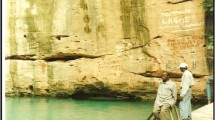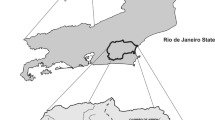Abstract
Water samples collected from the six reservoirs of Damodar River basin in pre- and post-monsoon, have been analysed, to study the major ion chemistry and the weathering and geochemical processes controlling the water composition. Ca, Na and HCO3 dominate the chemical composition of the reservoir water. The seasonal data shows a minimum concentration of most of the ions in post-monsoon and a maximum concentration in pre-monsoon seasons, reflecting the concentrating effects due to elevated temperature and increased evaporation during the low water level period of the pre-monsoon season. Water chemistry of the reservoirs strongly reflects the dominance of continental weathering aided by atmospheric and anthropogenic activities in the catchment area. Higher concentration of SO4 and TDS in Panchet, Durgapur and Tenughat reservoirs indicate mining and anthropogenic impact on water quality. The high contribution of (Ca+Mg) to the total cations, high concentration of dissolved silica, relatively high (Na+K)/TZ+ ratio (0.3) and low equivalent ratio of (Ca+Mg)/(Na+K) suggests combined influence of carbonate and silicate weathering. Kaolinite is the possible mineral that is in equilibrium with the water, implying that the chemistry of reservoir water favours kaolinite formation. The calculated values of SAR, RSC and sodium percentage indicate the ‘excellent to good quality’ of water for irrigation uses.










Similar content being viewed by others
References
APHA, AWWA, WPCF (1985) Standard methods for the examination of water and waste, 16th edn. Washington, DC
Appelo CA, Postma D (1993) Geochemistry, ground water and pollution. Balkema Rotterdam
Ballukraya PN, Ravi R (1999) Characterisation of ground water in the unconfined aquifers of Chenai city, India part 2-factor analysis. J Geol Soc Ind 54:13–22
Berner EK, Berner RA (1987) The global water cycle: geochemistry and environment. Prentice-Hall, Englewood Cliffs
Chakrapani GJ, Subramanian V (1990) Preliminary studies on the geochemistry of the Mahanadi river basin, India. Chem Geol 81:241–243
Davis JC (1986) Statistics and data analysis in geology. Wiley, New York
Drever JI (1988) The geochemistry of natural waters. Prentice Hall, Englewood Cliffs
Eaton FM (1950) Significance of carbonates in irrigation waters. Soil Sci 39:123–133
Forstner U, Wittmann GTW (1983) Metal pollution in the aquatic environment. Springer, Berlin Heidelberg New York
Gaillardet J, Dupre B, Louvat P, Allegre CJ (1999) Global silicate weathering and CO2 consumption rates deduced from the chemistry of large rivers. Chem Geol 59:3–30
Garrels RM, Christ CL (1965) Solutions, minerals and equilibria. Harper and Row, New York
Garrels RM, Mackenzie FT (1971) Gregor’s denudation of the continents. Nature 231:382–383
Ghose NC (1983) Geology, tectonics and evolution of the Chotanagpur granite-gneiss complex, eastern India. Recent researches in Geology Hindustan Publ Corp, Delhi 10:211–247
Gibbs RJ (1970) Mechanisms controlling world water chemistry. Science 17:1088–1090
Gupta LP, Subramanian V (1998) Geochemical factors controlling the chemical nature of water and sediments in the Gomti River, India. Environ Geol 30:1–21
Hardie LA, Eugster HP (1970) The evolution of closed-basin brines. Miner Soc Am Spec Publ 3:273–290
Meybeck M (1986) Compositiondes ruisseau non pollues de France. Sci Geo Bull 39:3–77
Milliman JD, Mead RH (1983) World wide delivery of river sediments to the oceans. J Geol 91:1–21
Milliot G (1970) Geology of clays. Springer, Berlin Heildelberg New York
Negrel P, Allegre CJ, Dupre B, Lewin E (1993) Erosion sources determined by inversion of major and trace element ratios and strontium isotopic ratios in river water: The Congo Basin case. Earth Planet Sci Lett 120:59–76
Pande K, Sarin MM, Trivedi JR, Krishnaswami S, Sharma KK (1994) The Indus River system (India-Pakistan): major-ion chemistry, uranium and strontium isotopes. Chem Geol 116:245–259
Piper AM (1944) A graphical procedure in the geochemical interpretation of water analysis. Am Geophys Union Trans 25:914–928
Raymahashay BC (1986) Geochemistry of bicarbonate in the river water. J Geol Soc India 27:114–118
Reeder SW, Hitchon B, Levinson AA (1972) Hydrogeochemistry of the surface waters of the Mackenzie drainage basin, Canada – Factor controlling inorganic composition. Geochim Casmochim Acta 36:825–865
Richards LA (1954) Diagnosis and improvement of saline and alkali soils. US Department of Agricultural Hand Book, No 60:160
Sarin MM, Krishnaswamy S (1984) Major ion chemistry of the Ganga and Brahmaputra river system, India. Nature 312:538–541
Sarin MM, Krishnaswamy S, Dilli K, Somayajulu BLK, Moore WS (1989) Major ion chemistry of the Ganga -Brahmaputra river system: weathering processes and fluxes to the Bay of Bengal. Geochim Cosmochim Acta 53:997–1009
Singh AK, Hasnain SI (1998) Major ion chemistry and control of weathering in a high altitude basin, Alaknanda, Garhwal Himalaya, India. Hydrol Science J 43:825–845
Singh AK, Hasnain SI (1999) Environmental geochemistry of Damodar river basin—east coast of India. Environ Geol 37:124–136
Singh AK, Hasnain SI (2002) Aspects of weathering and solute acquisition processes controlling chemistry of sub-alpine proglacial streams of Garhwal Himalaya, India. Hydrol Process 16:835–849
Stallard RF (1980) Major elements geochemistry of the Amazon River system. PhD Thesis, WHOI-80–29, MIT/Woods Hole Oceanogr Inst
Stallard RF, Edmond JM (1983) Geochemistry of the Amazon. 2 The influence of the geology and weathering environment on the dissolved load. J Geophys Res 88:9671–9688
Stumm W, Morgan JJ (1981) Aquatic chemistry. Wiley Interscience, New York
Subramanian V (1979) Chemical and suspended sediment characteristics of rivers of India. J Hydrol 44:37–55
Subramanian V (1987) Environmental geochemistry of Indian river basins-a review. J Geol Soc Ind 29:205–220
Subramanian V (1993) Sediments load of the Indian rivers. Cur Sci 64:928–930
Taylor SR, McLennan SM (1985) The continental crust: its composition and evolution. Blakwell, Oxford
Wilcox LV (1955) Classification and use of irrigation waters, USDA. Circ 969, Washington, DC
Zhang J, Huang WW, Letolle R, Jusserand C (1995) Major element chemistry of the Huanghe (Yellow river), China—weathering processes and chemical fluxes. J Hydrol 168:173–203
Acknowledgements
The authors are grateful to the Director, Central Mining Research Institute for his kind permission to publish this paper. AKS is thankful to Dept. Science & Technology, Govt. of India for financial assistance in the form of Fast Tack Project (SR/FTP/ES-99/2001). Help rendered by Mr. Suresh, KK Singh and A. Barat in analysis is thankfully acknowledged.
Author information
Authors and Affiliations
Corresponding author
Rights and permissions
About this article
Cite this article
Singh, A.K., Mondal, G.C., Singh, P.K. et al. Hydrochemistry of reservoirs of Damodar River basin, India: weathering processes and water quality assessment. Environ Geol 48, 1014–1028 (2005). https://doi.org/10.1007/s00254-005-1302-6
Received:
Accepted:
Published:
Issue Date:
DOI: https://doi.org/10.1007/s00254-005-1302-6




